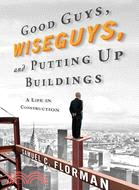相關商品
商品簡介
作者簡介
名人/編輯推薦
書摘/試閱
商品簡介
An engaging memoir about one man's career in construction--rising to the top of an industry renowned for crime, corruption, violence, physical danger, and the chronic risk of financial catastrophe.
Starting in the Navy Seabees at the end of WWII, Samuel C. Florman made his way as a general contractor in New York City through the period of explosive development, private exuberance and the historic growth of publicly supported housing--all amidst the rise of the notorious Mafia families,
and evolution of the Civil Rights Movement. His storied career brought him into contact with a variety of personalities: politicians and civil servants, developers and technocrats, saintly do-gooders and corrupt rapscallions. Along with the rousing adventures there were satisfactions of a different sort:
the enchantment of seeing architecture made real; the pride of creating housing, hospitals, schools, places of worship--shelter for the body and nourishment for the spirit.
Starting in the Navy Seabees at the end of WWII, Samuel C. Florman made his way as a general contractor in New York City through the period of explosive development, private exuberance and the historic growth of publicly supported housing--all amidst the rise of the notorious Mafia families,
and evolution of the Civil Rights Movement. His storied career brought him into contact with a variety of personalities: politicians and civil servants, developers and technocrats, saintly do-gooders and corrupt rapscallions. Along with the rousing adventures there were satisfactions of a different sort:
the enchantment of seeing architecture made real; the pride of creating housing, hospitals, schools, places of worship--shelter for the body and nourishment for the spirit.
作者簡介
Samuel C. Florman is the chairman of Kreisler Borg Florman General Construction Company. He has published six books and over 250 articles and has written numerous reviews forThe New York Times Book Review. He has spoken at many engineering schools and discussed professional topics on television and radio.
名人/編輯推薦
Reviews of THE EXISTENTIAL PLEASURES OF ENGINEERING:
"Clear, erudite, and occasionally eloquent, a useful read for engineers given to self-scrutiny and a stimulating one for the layman interested in the ancient schism between machines and men's souls."--Time
"Mr. Florman, an engineer, has a gift for prose and is, besides, a kindly, clear thinker."--The New Yorker
"Gracefully written. . .Refreshing and highly infectious enthusiasm. . .Imaginatively engineered."--The New York Times Book Review
"Clear, erudite, and occasionally eloquent, a useful read for engineers given to self-scrutiny and a stimulating one for the layman interested in the ancient schism between machines and men's souls."--Time
"Mr. Florman, an engineer, has a gift for prose and is, besides, a kindly, clear thinker."--The New Yorker
"Gracefully written. . .Refreshing and highly infectious enthusiasm. . .Imaginatively engineered."--The New York Times Book Review
書摘/試閱
ONE I Can Have You Killed for Fifty
THE CRIME TOOK PLACE in the Bronx on the northeast corner of Claflin Avenue and 195th Street. The perpetrators stood on the sidewalk adjoining a nearly completed six-story apartment house that my construction firm was building. When I arrived on the scene, three men were engaged in animated conversation. The masonry subcontractor, Lou, was pleading with a city inspector to grant him "just a few more minutes," and our construction superintendent, Norman, was saying something like "jeez, give the guy a break." I joined the group just in time to see the inspector shake his head and then say loudly, "No way, no how!" It seemed that a small forklift was being used to transport concrete blocks from a parked truck into the building, and a problem had arisen when no updated building permit could be produced. The discussion grew more and more heated, and for a moment I thought that the mason and the inspector were going to come to blows.
But suddenly the shouting stopped, and very quietly the inspector said, "OK." Pause. "It'll cost you a hundred bucks." Norman and I glanced at each other and cautiously backed away. But not before we heard Lou say softly, "Oh yeah? A hundred bucks." Then even more softly, "You gotta be kidding." Finally, almost in a whisper: "I can have you killed for fifty."
There was silence as the two men studied each other. After a moment, the inspector turned around, walked swiftly to his car, and drove away.
* * *
I refer to a crime, yet what had actually happened? On the face of it, a bribe was solicited and murder threatened while two witnesses-one of them me-stood by in stunned silence. But what if the verbal exchange was not meant to be taken literally? What if it was merely a ritualistic expression of intimidating bluster like two athletes talking trash on a basketball court? On the other hand, what if...?
Clearly the inspector took Lou's words seriously. Very seriously. And as I recall the scene, the atmosphere was charged with menace.
Whenever I tell the story it gets a laugh, or at least a smile. Partly this is because the tale contains a surprise punch line. But there is something else that entertains my audience-the shiver of fear, together with the comfort of personal safety, the very same frisson that makes it a special pleasure to view The Godfather or The Sopranos in the comfort and security of a theater or one's living room.
* * *
I start to write about my career as a builder and find myself leading with murder and intimidation. A touch of swagger and bravado? I suppose so. But not idle fantasy. In the words of the New York State Organized Crime Task Force (1990): "Historical and contemporary evidence, including our own criminal investigations, establish beyond any doubt that corruption and racketeering pervade New York City's construction industry." And, further, bearing on the incident just described: "The presence of so many known organized crime figures in the industry makes the explicit threat of violence credible and the implicit threat of violence sufficient." The implicit threat of violence was clearly enough to send one veteran building inspector quickly on his way.
The Mafia and construction are joined in the public's imagination-and, as amply documented-literally in the real world. But established criminal organizations have no monopoly on malfeasance in the industry. Society is not that neatly organized, corruption not so circumscribed. Wherever construction contracts are awarded and buildings erected, skulduggery seems endemic-among contractors, developers, tradesmen, politicians, purchasing agents, inspectors, and union delegates. The media report almost daily on every conceivable sort of misdeed-bribes, kickbacks, extortion, bid rigging, inflated claims, use of inferior materials, and more. Transparency International, the global coalition founded in 1993 by an array of highly respected individuals, cites construction as the single most corrupt industry that exists on the face of the earth. The contract award process appears to lend itself to underhanded dealings, stratagems that even competitive bidding cannot eliminate. The very activity of building is linked historically with cheating. Paradoxically, the many layers of supervision intended to monitor construction projects and guarantee propriety-the permits, change orders, regulations, approvals-provide unique opportunities for wrongdoing.
Adding to these time-honored problems, we find violence on the job sites, the belligerence of rugged men sometimes getting in one another's way, the perpetual conflict of union versus nonunion workers, and occasionally one trade fighting for its very existence, such as when, in the 1950s, drywall began to replace plaster. The Civil Rights Movement saw minority workers battling for their rightful share of employment and then, in some cities, falling prey to labor racketeers. In New York in the 1980s aggressive gangs swept down on building sites in yellow school buses, demanding jobs but seeking payoffs and kickbacks, often two or more mobs competing, sometimes with gunplay involved.
Beyond crime, corruption, and violent intimidation, building construction, in its very nature, is rough and tough and turbulent. Visit any job site. Motion and noise. Monstrous machines, enormous beams, cables swaying, concrete hoisted aloft in buckets. The weather-sometimes frigid, sometimes sweltering-adds to the feeling of adventure. Observe the men, the hardhats: boisterous, seeming as strong and hardy as the tools they wield; rugged, macho, toiling deep in the earth and high into the sky, as much a part of American mythology as the cowboys of earlier days. (There are a few women on the jobs, but very few.)
In a busy city most citizens walk by construction sites with hardly a glance. And even sidewalk superintendents may idle away the time wrapped in their own thoughts. Yet alert observers cannot help but feel the pulse-quickening excitement infused with a sense of danger.
And the danger is real, independent of crime and conflict. In the United States there are more workers killed in construction than in any other single industry. The death rate per capita may be slightly higher in a few other occupations-notably logging, ranching, fishing, and mining-but the 1,000 to 1,300 annual construction fatalities is the largest number for any industry sector and represents approximately one in every five recorded in the nation. As might be expected, the number of nonfatal injuries is also extremely high. Nor are the perils limited to workers on the job. Frequently a passerby-or even a citizen hundreds of yards distant from a building site-is injured or even killed in a freak accident.
After the construction process ends, the hazards associated with man-made structures do not disappear. Buildings, new and old, shed bricks and stone, sometimes with deadly consequence, or even collapse, explode, or spew steam from broken pipes. Physical perils naturally have financial consequence, as evidenced by the extremely high insurance rates associated with the activity of building.
* * *
THIS litany of menace brings us inevitably to the phenomenon of financial disaster. Physical mishap is only one of the many dangers that confront the builder. Business risk has burrowed into the very marrow of the construction industry, making it America's most perilous enterprise, except for restaurants, as a percentage of company failures. In any given two-year period almost a quarter of the nation's non-single-family construction firms close their doors. Half of new firms fail within four years, three-quarters within ten years. Part of this stems from the ease with which the adventurous can enter the field-all it takes is a few tools, a few dollars, and some guts. But, while a large majority of the nation's 7.2 million salaried construction workers are employed by very small companies-five employees and fewer-financial ruin stalks firms of every size. The top 400 contractors-those whose annual volume runs from the $150 million range to several billion-do more than 20 percent of the nation's $1-1.25 trillion building and take a sizeable share of the financial setbacks. Every year sees large, long-established firms incur devastating losses.
According to a report prepared by FMI Corp., a top management consultant, the typical contractor is "numb to risk," exhibiting "a heroic audacity." There is probably some truth to this view, but I think it underestimates the treacherous nature of the business and the role of bad luck. Be this as it may, to quote an often heard maxim, in the construction industry financial ruin is "just one bad job away."
* * *
SO, how did I get into this business? Quiet by nature; devoted to family; a lover of books, opera, and the New York baseball Giants-I was a high-achieving student who once thought of becoming a mathematician or possibly a physicist. I never liked riding my bike too fast, much less doing the reckless things that appeal to so many thrill seekers. I don't much care for heights or for gambling, even when I win. Not that I'm totally immune to the attractions of risk. None of us is. Scientists tell us we enjoy the charge of dopamine that accompanies danger because taking chances helped early humans find food and mates, hence the genes that favor daring are within us all. It's a question of degree, however, and, though I enjoy adventure stories and cowboy movies, watching sports on TV, even-once upon a time-playing a rugged game of soccer, I don't fancy that my quota of peril-loving genes is very high. Also, assuming that we are shaped by nurture as well as nature, there was little about my childhood environment that would have contributed to making me a daredevil. As a city kid I occasionally dashed between moving cars, rode the subways alone, and even shared forbidden ventures into the West Side railroad yards. But each time I left home, my parents' parting admonition was, "Watch your crossings!" and to a certain extent I always have.
As for corruption-jeepers! For twelve years, in the 1930s and 1940s, I attended the Ethical Culture Fieldston School in New York City, taking an ethics class at least once a week. Not that a few hundred ethics classes make for a good person; but the school was serious in its purpose and, in good measure I believe, effective. Also, like many kids of my time and place, I was taught to "behave," certainly to respect authority and obey the law. Pranks and a few white lies-well, that was to be expected; but criminal malfeasance, action that might bring shame on the family-that was, and is, a horror beyond imagining.
And yet I've made my career in the construction industry, which is renowned for crime, corruption, violence, physical danger, and chronic risk of financial catastrophe.
I look back on this career with relish, not, I hasten to say, because I engaged in crime, corruption, and the rest, but because of the challenges met, the rousing adventures encountered. Also there have been satisfactions of a different sort: the enchantment of seeing architecture made real; the pleasure of solving complex technical problems; the pride of creating housing, hospitals, schools, places of worship-shelter for the body and nourishment for the spirit. And wonderful people met on the journey-along with a challenging assortment of knaves.
THE CRIME TOOK PLACE in the Bronx on the northeast corner of Claflin Avenue and 195th Street. The perpetrators stood on the sidewalk adjoining a nearly completed six-story apartment house that my construction firm was building. When I arrived on the scene, three men were engaged in animated conversation. The masonry subcontractor, Lou, was pleading with a city inspector to grant him "just a few more minutes," and our construction superintendent, Norman, was saying something like "jeez, give the guy a break." I joined the group just in time to see the inspector shake his head and then say loudly, "No way, no how!" It seemed that a small forklift was being used to transport concrete blocks from a parked truck into the building, and a problem had arisen when no updated building permit could be produced. The discussion grew more and more heated, and for a moment I thought that the mason and the inspector were going to come to blows.
But suddenly the shouting stopped, and very quietly the inspector said, "OK." Pause. "It'll cost you a hundred bucks." Norman and I glanced at each other and cautiously backed away. But not before we heard Lou say softly, "Oh yeah? A hundred bucks." Then even more softly, "You gotta be kidding." Finally, almost in a whisper: "I can have you killed for fifty."
There was silence as the two men studied each other. After a moment, the inspector turned around, walked swiftly to his car, and drove away.
* * *
I refer to a crime, yet what had actually happened? On the face of it, a bribe was solicited and murder threatened while two witnesses-one of them me-stood by in stunned silence. But what if the verbal exchange was not meant to be taken literally? What if it was merely a ritualistic expression of intimidating bluster like two athletes talking trash on a basketball court? On the other hand, what if...?
Clearly the inspector took Lou's words seriously. Very seriously. And as I recall the scene, the atmosphere was charged with menace.
Whenever I tell the story it gets a laugh, or at least a smile. Partly this is because the tale contains a surprise punch line. But there is something else that entertains my audience-the shiver of fear, together with the comfort of personal safety, the very same frisson that makes it a special pleasure to view The Godfather or The Sopranos in the comfort and security of a theater or one's living room.
* * *
I start to write about my career as a builder and find myself leading with murder and intimidation. A touch of swagger and bravado? I suppose so. But not idle fantasy. In the words of the New York State Organized Crime Task Force (1990): "Historical and contemporary evidence, including our own criminal investigations, establish beyond any doubt that corruption and racketeering pervade New York City's construction industry." And, further, bearing on the incident just described: "The presence of so many known organized crime figures in the industry makes the explicit threat of violence credible and the implicit threat of violence sufficient." The implicit threat of violence was clearly enough to send one veteran building inspector quickly on his way.
The Mafia and construction are joined in the public's imagination-and, as amply documented-literally in the real world. But established criminal organizations have no monopoly on malfeasance in the industry. Society is not that neatly organized, corruption not so circumscribed. Wherever construction contracts are awarded and buildings erected, skulduggery seems endemic-among contractors, developers, tradesmen, politicians, purchasing agents, inspectors, and union delegates. The media report almost daily on every conceivable sort of misdeed-bribes, kickbacks, extortion, bid rigging, inflated claims, use of inferior materials, and more. Transparency International, the global coalition founded in 1993 by an array of highly respected individuals, cites construction as the single most corrupt industry that exists on the face of the earth. The contract award process appears to lend itself to underhanded dealings, stratagems that even competitive bidding cannot eliminate. The very activity of building is linked historically with cheating. Paradoxically, the many layers of supervision intended to monitor construction projects and guarantee propriety-the permits, change orders, regulations, approvals-provide unique opportunities for wrongdoing.
Adding to these time-honored problems, we find violence on the job sites, the belligerence of rugged men sometimes getting in one another's way, the perpetual conflict of union versus nonunion workers, and occasionally one trade fighting for its very existence, such as when, in the 1950s, drywall began to replace plaster. The Civil Rights Movement saw minority workers battling for their rightful share of employment and then, in some cities, falling prey to labor racketeers. In New York in the 1980s aggressive gangs swept down on building sites in yellow school buses, demanding jobs but seeking payoffs and kickbacks, often two or more mobs competing, sometimes with gunplay involved.
Beyond crime, corruption, and violent intimidation, building construction, in its very nature, is rough and tough and turbulent. Visit any job site. Motion and noise. Monstrous machines, enormous beams, cables swaying, concrete hoisted aloft in buckets. The weather-sometimes frigid, sometimes sweltering-adds to the feeling of adventure. Observe the men, the hardhats: boisterous, seeming as strong and hardy as the tools they wield; rugged, macho, toiling deep in the earth and high into the sky, as much a part of American mythology as the cowboys of earlier days. (There are a few women on the jobs, but very few.)
In a busy city most citizens walk by construction sites with hardly a glance. And even sidewalk superintendents may idle away the time wrapped in their own thoughts. Yet alert observers cannot help but feel the pulse-quickening excitement infused with a sense of danger.
And the danger is real, independent of crime and conflict. In the United States there are more workers killed in construction than in any other single industry. The death rate per capita may be slightly higher in a few other occupations-notably logging, ranching, fishing, and mining-but the 1,000 to 1,300 annual construction fatalities is the largest number for any industry sector and represents approximately one in every five recorded in the nation. As might be expected, the number of nonfatal injuries is also extremely high. Nor are the perils limited to workers on the job. Frequently a passerby-or even a citizen hundreds of yards distant from a building site-is injured or even killed in a freak accident.
After the construction process ends, the hazards associated with man-made structures do not disappear. Buildings, new and old, shed bricks and stone, sometimes with deadly consequence, or even collapse, explode, or spew steam from broken pipes. Physical perils naturally have financial consequence, as evidenced by the extremely high insurance rates associated with the activity of building.
* * *
THIS litany of menace brings us inevitably to the phenomenon of financial disaster. Physical mishap is only one of the many dangers that confront the builder. Business risk has burrowed into the very marrow of the construction industry, making it America's most perilous enterprise, except for restaurants, as a percentage of company failures. In any given two-year period almost a quarter of the nation's non-single-family construction firms close their doors. Half of new firms fail within four years, three-quarters within ten years. Part of this stems from the ease with which the adventurous can enter the field-all it takes is a few tools, a few dollars, and some guts. But, while a large majority of the nation's 7.2 million salaried construction workers are employed by very small companies-five employees and fewer-financial ruin stalks firms of every size. The top 400 contractors-those whose annual volume runs from the $150 million range to several billion-do more than 20 percent of the nation's $1-1.25 trillion building and take a sizeable share of the financial setbacks. Every year sees large, long-established firms incur devastating losses.
According to a report prepared by FMI Corp., a top management consultant, the typical contractor is "numb to risk," exhibiting "a heroic audacity." There is probably some truth to this view, but I think it underestimates the treacherous nature of the business and the role of bad luck. Be this as it may, to quote an often heard maxim, in the construction industry financial ruin is "just one bad job away."
* * *
SO, how did I get into this business? Quiet by nature; devoted to family; a lover of books, opera, and the New York baseball Giants-I was a high-achieving student who once thought of becoming a mathematician or possibly a physicist. I never liked riding my bike too fast, much less doing the reckless things that appeal to so many thrill seekers. I don't much care for heights or for gambling, even when I win. Not that I'm totally immune to the attractions of risk. None of us is. Scientists tell us we enjoy the charge of dopamine that accompanies danger because taking chances helped early humans find food and mates, hence the genes that favor daring are within us all. It's a question of degree, however, and, though I enjoy adventure stories and cowboy movies, watching sports on TV, even-once upon a time-playing a rugged game of soccer, I don't fancy that my quota of peril-loving genes is very high. Also, assuming that we are shaped by nurture as well as nature, there was little about my childhood environment that would have contributed to making me a daredevil. As a city kid I occasionally dashed between moving cars, rode the subways alone, and even shared forbidden ventures into the West Side railroad yards. But each time I left home, my parents' parting admonition was, "Watch your crossings!" and to a certain extent I always have.
As for corruption-jeepers! For twelve years, in the 1930s and 1940s, I attended the Ethical Culture Fieldston School in New York City, taking an ethics class at least once a week. Not that a few hundred ethics classes make for a good person; but the school was serious in its purpose and, in good measure I believe, effective. Also, like many kids of my time and place, I was taught to "behave," certainly to respect authority and obey the law. Pranks and a few white lies-well, that was to be expected; but criminal malfeasance, action that might bring shame on the family-that was, and is, a horror beyond imagining.
And yet I've made my career in the construction industry, which is renowned for crime, corruption, violence, physical danger, and chronic risk of financial catastrophe.
I look back on this career with relish, not, I hasten to say, because I engaged in crime, corruption, and the rest, but because of the challenges met, the rousing adventures encountered. Also there have been satisfactions of a different sort: the enchantment of seeing architecture made real; the pleasure of solving complex technical problems; the pride of creating housing, hospitals, schools, places of worship-shelter for the body and nourishment for the spirit. And wonderful people met on the journey-along with a challenging assortment of knaves.
主題書展
更多
主題書展
更多書展本週66折
您曾經瀏覽過的商品
購物須知
外文書商品之書封,為出版社提供之樣本。實際出貨商品,以出版社所提供之現有版本為主。部份書籍,因出版社供應狀況特殊,匯率將依實際狀況做調整。
無庫存之商品,在您完成訂單程序之後,將以空運的方式為你下單調貨。為了縮短等待的時間,建議您將外文書與其他商品分開下單,以獲得最快的取貨速度,平均調貨時間為1~2個月。
為了保護您的權益,「三民網路書店」提供會員七日商品鑑賞期(收到商品為起始日)。
若要辦理退貨,請在商品鑑賞期內寄回,且商品必須是全新狀態與完整包裝(商品、附件、發票、隨貨贈品等)否則恕不接受退貨。
























